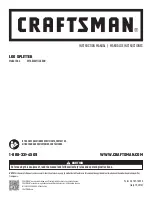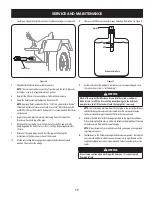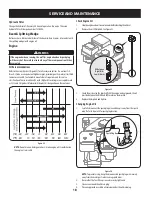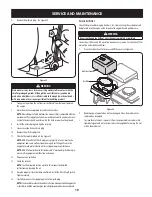
4
SAFETY INSTRUCTIONS
•
Always operate this machine from the operator zone(s) specified in the
manual. See Figure 1.
Horizontal
Vertical
Figure 1
•
Logs should be cut with square ends prior to splitting.
•
Use log splitter in daylight or under good artificial light.
Safe Handling of Gasoline:
To avoid personal injury or property damage use extreme care in handling
gasoline. Gasoline is extremely flammable and the vapors are explosive.
Serious personal injury can occur when gasoline is spilled on yourself or your
clothes which can ignite. Wash your skin and change clothes immediately.
•
Use only an approved gasoline container.
•
Extinguish all cigarettes, cigars, pipes, and other sources of ignition.
•
Never fuel machine indoors.
•
Never remove gas cap or add fuel while the engine is hot or running.
•
Allow engine to cool at least two minutes before refueling.
•
Never overfill the fuel tank. Fill tank to no more than 1/2 inch below bottom
of filler neck to provide space for fuel expansion.
•
Replace gasoline cap and tighten securely.
•
If gasoline is spilled, wipe it off the engine and equipment and move
machine to another area. Wait five (5) minutes before starting the engine.
•
Never store the machine or fuel container inside where there is an open
flame, spark or pilot light as on a water heater, space heater, furnace, clothes
dryer or other gas appliances.
•
Allow machine to cool at least five (5) minutes before storing
OPERATION
•
Before starting this machine, review the “Safety Instructions”. Failure to
follow these rules may result in serious injury to the operator or bystanders.
•
Never leave this machine unattended with the engine running.
•
Do not operate machine while under the influence of alcohol, drugs, or
medication.
•
Never allow anyone to operate this machine without proper instruction.
•
Always operate this machine with all safety equipment in place and working.
Make sure all controls are operating properly for safe operation.
•
Operator Zone
a. Horizontal Operating Position: Stand on the control lever side of the
log splitter and stabilize log as shown, if needed. See Figure 1.
b. Vertical Operating Position: Stand in front of the log splitter and
stabilize log as shown, if needed. See Figure 1.
WARNING
When stabilizing log with left hand, remove your hand when the wedge
just contacts the log or serious injury may occur.
•
When loading a log, always place your hands on the side of the log, not on
the ends, and never use your foot to help stabilize a log. Failure to do so, may
result in crushed or amputated fingers, toes, hand, or foot.
•
Use only your right hand to operate the controls.
•
Never attempt to split more than one log at a time.
•
For logs which are not cut square, the least square end and the longest
portion of the log should be placed toward the beam and wedge, and the
square end placed toward the end plate.
•
When splitting in the vertical position, stabilize the log before moving the
control handle. Split as follows:
a. Place log on the end plate and turn until it leans against the beam
and is stable.
a. When splitting extra large or uneven logs, the log must be stabilized
with wooden shims or split wood between the log and end plate or
ground.
•
Always keep fingers away from any cracks that open in the log while
splitting. They can quickly close and pinch or amputate your fingers.
•
Keep your work area clean. Immediately remove split wood around the
machine so you do not stumble over it.
•
Do not change the engine governor settings or overspeed the engine. The
governor controls the maximum safe operating speed of the engine.
•
Never move this machine while the engine is running.
•
This machine should not be towed on any street, highway or public road
without checking the existing federal, state, or local vehicle requirements.
Any licensing or modifications such as taillights, etc., needed to comply, is
the sole responsibility of the purchaser. If a “Statement of Origin” is required
in your state, see your local dealer.
•
Do not tow machine over 45 mph.
•
See Transporting the Log Splitter section in this manual for proper towing
instructions once all federal, local, or state requirements are met.


























